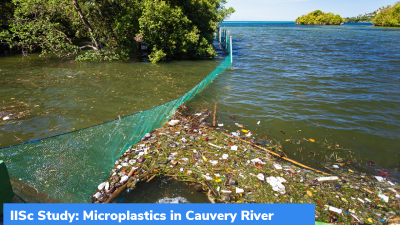IISc Study: Microplastics in Cauvery River

A new study has revealed that pollutants like microplastics might be causing growth defects like skeletal deformities in the fishes of the Cauvery river. The study has been published in the journal named Ecotoxicology and Environmental Safety.
Overview:
- Upendra Nongthomba of the Indian Institute of Science (IISc) Bengaluru, has led this study.
- The first author of the study is Abass Toba Anifowoshe, a PhD student in Nongthomba’s lab.
How was the study conducted?
A study of the pollution level at the KRS Dam and the effects it has on fish was conducted by Nongthomba’s lab. Water samples were collected by the researchers from three different locations having varying water speeds i.e. slow-flowing, fast-flowing, and stagnant as the speed of water affects the concentration of pollutants.
The first part of the study
In the study’s first part, the chemical and physical parameters of the water samples were analyzed by the team. Out of all the samples analyzed only one of them was within prescribed limits. In the samples that were collected the exception found was dissolved oxygen, the levels of which were much lower than they needed to be in stagnant and slow-flowing sites. Water that was collected from these sites also had microbes like Daphnia, Cyclops, Spirochaeta, Spirogyra, and E. coli, which are bio-indicators for water contamination.
Raman spectroscopy technique was used by the researchers to detect microplastics and cyclohexyl functional group toxic chemicals. Microplastics can be found in several industrial and household products, and toxic chemicals are used in the pharmaceutical and agriculture industry.
The second part of the study
In the study’s second part, the team investigated whether the water pollutants could be the reason for deformities seen in wild fishes. Embryos of zebrafish, with the collected water samples from the three sites, were treated and it was found that those that were exposed to water collected from the stagnant and slow-flowing sites experienced DNA damage, skeletal deformities, heart damage, early cell death, and increased mortality.
Reactive Oxygen Species
Unstable molecules named ROS (Reactive Oxygen Species) were also found by the researchers in the cells of the abnormally developed fishes. ROS damages DNA and affects animals in a similar manner as those fishes that were treated with water from the stagnant and slow-flowing sites.






